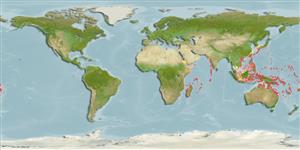Common names from other countries
Environment: milieu / climate zone / depth range / distribution range
Ekologi
Berasosiasi dengan karang; kisaran kedalaman 0 - 25 m (Ref. 108901), usually 0 - 10 m (Ref. 108901). Tropical
Indo-West Pacific: East Africa to Papua New Guinea and Australia.
Length at first maturity / Size / Weight / umur
Maturity: Lm ? range ? - ? cm Max length : 48.0 cm TL jantan/; (Ref. 80470); common length : 35.0 cm TL jantan/; (Ref. 80470); Berat maksimum terpublikasi: 2.8 kg (Ref. 122)
Maximum depth from Ref. 92930. Found on inner reef flats, coastal lagoons, seagrass beds, or sandflats at depths of 0 to 30 m (Ref. 92930). Occurs predominantly from 0 to 10 m (Ref. 98471). During specific time of the day, it buries in sand or muddy-sand (Ref. 92930).
Life cycle and mating behavior
Kematangan | Reproduksi, perkembang biakan | Pemijahan | telur-telur | Fecundity | Larva
Members of the class Holothuroidea are gonochoric and have only one gonad. Spawning and fertilization are both external and some exhibit brooding. Life cycle: Embryos develop into planktotrophic larvae (auricularia) then into doliolaria (barrel-shaped stage) which later metamorphose into juvenile sea cucumbers.
rujukan utama
Acuan | Koordinator | mitra
Massin, C., S. Uthicke, S.W. Purcell, F.W.E. Rowe and Y. Samyn. 2009. (Ref. 80470)
Status IUCN Red List (Ref. 130435)
status CITES (Ref. 108899)
Not Evaluated
Not Evaluated
ancaman kepada manusia
Harmless
penggunaan manusia
Perikanan: bernilai komersial tinggi
FAO - Perikanan: landings | FishSource |
Alat, peralatan
informasi lanjut
Umur / Saiz
Pertumbuhan
panjang-berat
panjang-panjang
Morfologi
Larva
Kelimpahan
Sumber internet
Estimates based on models
Preferred temperature
(Ref.
115969): 24.7 - 29.3, mean 28.2 (based on 1951 cells).
